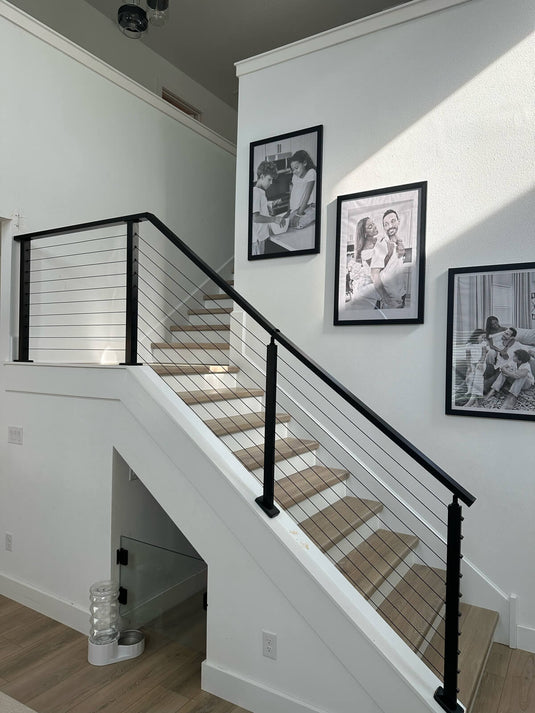TABLE OF CONTENTS
Do You Need a Top Rail for Cable Railing?
Quick Answer
Yes, in most cases you do need a top rail for cable railing for both safety and structural integrity. It helps distribute the tension of the cables, keeps the structure secure, and prevents the cables from sagging or spreading apart too much. While you might be tempted by the minimalist look without a top rail, it's crucial to consider factors such as the potential for more frequent maintenance and the need for extra safety, especially in high-traffic areas or environments exposed to variable weather.
Introduction
Cable railings are popular for their clean lines and modern look, but there's a big question that often comes up when installing them: do you really need the top rail? In this article, we're going to take a close look at what top rails do, why they might be important for safety, and what the rules say about having them. We'll help you figure out if that top bar is a must-have or if you can skip it while still keeping everything safe and looking great.
Why Top Rails Matter in Cable Railing Systems
When you see a cable railing, the first things that catch your eye are usually the slender cables and maybe the posts that hold everything up. But what about that bar running across the top? That's the top rail, and it's more important than you might think.

Keeping It All Together
Think of the top rail like the keystone in an arch; it locks everything into place. Without it, the posts that hold the cables could lean or wobble because the tension from the cables is pretty strong. The top rail helps to spread out this tension, so no single post has to take all the pressure. This keeps your railing sturdy and stops the cables from sagging over time.
Holding on for Safety
Safety is key when it comes to any structure in your home, and handrails are a big part of that. Top rails give you something to grab onto, which is especially important on stairs or higher levels. They also stop the cables from spreading apart too much if someone or something pushes against them — imagine a kid pressing on the cables like a harp. That cable railing with top rail ensures each cable stays close together, so nothing slips through.
What Do the Rules Say?
Building codes aren't just there to make life complicated; they're about keeping us safe. Depending on where you live, there'll be rules (like Occupational Safety and Health Administration) saying how railings should be built. These codes often mention that railings need a gripping surface — and yes, that often means a top rail. So even if you're not sold on the idea for safety or stability, the law might require it anyway.
Is Skipping the Top Rail an Option?
You've got your heart set on that minimalist, floating-cable look for your deck, and you're wondering if the top rail can take a hike. Let's explore when it's possible to ditch the top rail, and what that really means for your space.
When Less is More
Not every cable railing demands a top rail. Sometimes, the design or the way the system is engineered allows you to go without one. For instance, if the posts are super sturdy and engineered to withstand the tension of the cables by themselves, you might have the green light to leave out the top rail. But this isn't a one-size-fits-all deal; it's crucial to get a thumbs-up from a professional who can say for sure whether your setup will be safe and solid without the top piece. For expert assistance ensuring your cable railing is safe and stylish, consider reaching out to Muzata.
Weighing the Pros and Cons
Let's talk looks versus practicality. Ditching the top rail can give your space a more open and uncluttered feel – it’s like having an uninterrupted view of your backyard or vista. However, it's not all about aesthetics. Without a top rail, you might find yourself on a maintenance merry-go-round, as those cables may need more frequent adjustments to keep the tension just right. Plus, without that extra buffer up top, there’s a smidge less protection against someone leaning a bit too far over the edge.
Before making a 'no top rail' decision, it's smart to consider these trade-offs. It’s about balancing what catches your eye with what keeps your railing working right and lasting long.
So, is skipping the top rail truly an option? Yes, in some cases, but it comes with homework. You need to check the stability, get expert advice, and seriously think about how much upkeep you're willing to handle. Up next, let's dive into the nitty-gritty of what to think about before you decide to break up with the top rail.
Things to Mull Over Before Going Top Rail-Free
Now that you're considering whether a top rail fits into your vision for a cable railing system, let's pause and sift through some key factors. Deciding to leave out a top rail isn't just about the "wow" factor or the simplicity of the design; it's also about making sure the railing does its job in the long run.
Matching the Railing to Your Place
Where's this railing going to live? If we're talking about a busy coffee shop with a balcony, the safety requirements could be different from those of a private home. Commercial spots often have stricter codes because they serve all sorts of people every day. In homes, while you still need to play by the rules, you might have more wiggle room for personal preference.
Thinking About Who's Using It
Picture who'll be hanging around these railings. Is your deck going to be a chill-out zone for adults, or is it a racetrack for a bunch of energetic kids? The answers can sway your decision. High-traffic areas or places frequented by children and the elderly might demand the extra security of a top rail.
Considering the Weather's Whims
Mother Nature has her moods, and she doesn't go easy on outdoor structures. If your place gets hit with everything from scorching sun to freezing snow, remember that the weather can affect the tension and durability of your cables. A top rail can offer that extra bit of resilience against the elements.
Balancing Costs Now and Later
Think of it like buying a car: paying more upfront for a model with all the safety features versus saving some cash on a basic version but potentially paying more in maintenance later. The same goes for your railing. Investing in a top rail could save you time and money on upkeep down the line.
So, as you're sketching out your dream railing, keep these thoughts in mind. It's not just about the immediate impact; it's also about how it fits into the larger picture of your life and your home's needs. With these insights under your belt, you're better equipped to make a choice that you'll be happy with for years to come.
The Bottome Line
Going for a sleek, top-rail-free look? Make sure to tick all the boxes for safety and code compliance with help from an expert. Love the minimalist vibe but want to stay on the safe side? The right balance can still be struck within the guidelines. Remember, a top rail for cable railing stability is crucial for ensuring the cables stay secure and taut. Either way, your choice should reflect a blend of smart design, enduring safety, and keen attention to detail. With the groundwork laid and the rules in mind, you're ready to shape a space that's uniquely yours, setting the stage for years of enjoyment—top rail or not.




